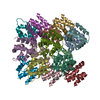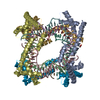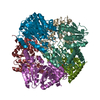+ Open data
Open data
- Basic information
Basic information
| Entry | Database: PDB / ID: 3j63 | ||||||
|---|---|---|---|---|---|---|---|
| Title | Unified assembly mechanism of ASC-dependent inflammasomes | ||||||
 Components Components | Apoptosis-associated speck-like protein containing a CARD | ||||||
 Keywords Keywords |  APOPTOSIS / helical polymer / variable twist / APOPTOSIS / helical polymer / variable twist /  death domain death domain | ||||||
| Function / homology |  Function and homology information Function and homology information Pyrin domain binding / NLRP6 inflammasome complex / Pyrin domain binding / NLRP6 inflammasome complex /  myosin I binding / positive regulation of antigen processing and presentation of peptide antigen via MHC class II / myeloid dendritic cell activation involved in immune response / regulation of intrinsic apoptotic signaling pathway / myeloid dendritic cell activation / myosin I binding / positive regulation of antigen processing and presentation of peptide antigen via MHC class II / myeloid dendritic cell activation involved in immune response / regulation of intrinsic apoptotic signaling pathway / myeloid dendritic cell activation /  IkappaB kinase complex / The AIM2 inflammasome / AIM2 inflammasome complex ... IkappaB kinase complex / The AIM2 inflammasome / AIM2 inflammasome complex ... Pyrin domain binding / NLRP6 inflammasome complex / Pyrin domain binding / NLRP6 inflammasome complex /  myosin I binding / positive regulation of antigen processing and presentation of peptide antigen via MHC class II / myeloid dendritic cell activation involved in immune response / regulation of intrinsic apoptotic signaling pathway / myeloid dendritic cell activation / myosin I binding / positive regulation of antigen processing and presentation of peptide antigen via MHC class II / myeloid dendritic cell activation involved in immune response / regulation of intrinsic apoptotic signaling pathway / myeloid dendritic cell activation /  IkappaB kinase complex / The AIM2 inflammasome / AIM2 inflammasome complex / IkappaB kinase complex / The AIM2 inflammasome / AIM2 inflammasome complex /  macropinocytosis / NLRP1 inflammasome complex / icosanoid biosynthetic process / macropinocytosis / NLRP1 inflammasome complex / icosanoid biosynthetic process /  interleukin-6 receptor binding / NLRP3 inflammasome complex assembly / canonical inflammasome complex / positive regulation of adaptive immune response / interleukin-6 receptor binding / NLRP3 inflammasome complex assembly / canonical inflammasome complex / positive regulation of adaptive immune response /  NLRP3 inflammasome complex / BMP receptor binding / osmosensory signaling pathway / negative regulation of protein serine/threonine kinase activity / negative regulation of interferon-beta production / CLEC7A/inflammasome pathway / positive regulation of cysteine-type endopeptidase activity / regulation of tumor necrosis factor-mediated signaling pathway / positive regulation of extrinsic apoptotic signaling pathway / positive regulation of macrophage cytokine production / pattern recognition receptor signaling pathway / NLRP3 inflammasome complex / BMP receptor binding / osmosensory signaling pathway / negative regulation of protein serine/threonine kinase activity / negative regulation of interferon-beta production / CLEC7A/inflammasome pathway / positive regulation of cysteine-type endopeptidase activity / regulation of tumor necrosis factor-mediated signaling pathway / positive regulation of extrinsic apoptotic signaling pathway / positive regulation of macrophage cytokine production / pattern recognition receptor signaling pathway /  tropomyosin binding / positive regulation of actin filament polymerization / negative regulation of NF-kappaB transcription factor activity / positive regulation of activated T cell proliferation / tropomyosin binding / positive regulation of actin filament polymerization / negative regulation of NF-kappaB transcription factor activity / positive regulation of activated T cell proliferation /  pyroptosis / cysteine-type endopeptidase activator activity involved in apoptotic process / positive regulation of release of cytochrome c from mitochondria / positive regulation of cysteine-type endopeptidase activity involved in apoptotic process / positive regulation of interleukin-10 production / The NLRP3 inflammasome / intrinsic apoptotic signaling pathway by p53 class mediator / intrinsic apoptotic signaling pathway in response to DNA damage by p53 class mediator / negative regulation of cytokine production involved in inflammatory response / positive regulation of T cell migration / cellular response to interleukin-1 / pyroptosis / cysteine-type endopeptidase activator activity involved in apoptotic process / positive regulation of release of cytochrome c from mitochondria / positive regulation of cysteine-type endopeptidase activity involved in apoptotic process / positive regulation of interleukin-10 production / The NLRP3 inflammasome / intrinsic apoptotic signaling pathway by p53 class mediator / intrinsic apoptotic signaling pathway in response to DNA damage by p53 class mediator / negative regulation of cytokine production involved in inflammatory response / positive regulation of T cell migration / cellular response to interleukin-1 /  Purinergic signaling in leishmaniasis infection / positive regulation of phagocytosis / negative regulation of canonical NF-kappaB signal transduction / positive regulation of chemokine production / positive regulation of defense response to virus by host / tumor necrosis factor-mediated signaling pathway / activation of innate immune response / positive regulation of interleukin-1 beta production / Purinergic signaling in leishmaniasis infection / positive regulation of phagocytosis / negative regulation of canonical NF-kappaB signal transduction / positive regulation of chemokine production / positive regulation of defense response to virus by host / tumor necrosis factor-mediated signaling pathway / activation of innate immune response / positive regulation of interleukin-1 beta production /  regulation of autophagy / positive regulation of interleukin-8 production / positive regulation of JNK cascade / regulation of autophagy / positive regulation of interleukin-8 production / positive regulation of JNK cascade /  regulation of protein stability / protein homooligomerization / positive regulation of inflammatory response / positive regulation of interleukin-6 production / positive regulation of non-canonical NF-kappaB signal transduction / activation of cysteine-type endopeptidase activity involved in apoptotic process / SARS-CoV-1 activates/modulates innate immune responses / positive regulation of DNA-binding transcription factor activity / azurophil granule lumen / positive regulation of T cell activation / positive regulation of type II interferon production / positive regulation of tumor necrosis factor production / cellular response to tumor necrosis factor / positive regulation of NF-kappaB transcription factor activity / defense response to virus / secretory granule lumen / cellular response to lipopolysaccharide / regulation of protein stability / protein homooligomerization / positive regulation of inflammatory response / positive regulation of interleukin-6 production / positive regulation of non-canonical NF-kappaB signal transduction / activation of cysteine-type endopeptidase activity involved in apoptotic process / SARS-CoV-1 activates/modulates innate immune responses / positive regulation of DNA-binding transcription factor activity / azurophil granule lumen / positive regulation of T cell activation / positive regulation of type II interferon production / positive regulation of tumor necrosis factor production / cellular response to tumor necrosis factor / positive regulation of NF-kappaB transcription factor activity / defense response to virus / secretory granule lumen / cellular response to lipopolysaccharide /  protease binding / defense response to Gram-negative bacterium / protease binding / defense response to Gram-negative bacterium /  microtubule / transmembrane transporter binding / positive regulation of ERK1 and ERK2 cascade / microtubule / transmembrane transporter binding / positive regulation of ERK1 and ERK2 cascade /  protein dimerization activity / defense response to Gram-positive bacterium / positive regulation of apoptotic process / protein dimerization activity / defense response to Gram-positive bacterium / positive regulation of apoptotic process /  Golgi membrane / Golgi membrane /  innate immune response / neuronal cell body / apoptotic process / Neutrophil degranulation / innate immune response / neuronal cell body / apoptotic process / Neutrophil degranulation /  nucleolus / nucleolus /  enzyme binding / enzyme binding /  endoplasmic reticulum / endoplasmic reticulum /  signal transduction / protein homodimerization activity / protein-containing complex / signal transduction / protein homodimerization activity / protein-containing complex /  mitochondrion / extracellular region / mitochondrion / extracellular region /  nucleoplasm / identical protein binding / nucleoplasm / identical protein binding /  nucleus / nucleus /  cytosol / cytosol /  cytoplasm cytoplasmSimilarity search - Function | ||||||
| Biological species |   Homo sapiens (human) Homo sapiens (human) | ||||||
| Method |  ELECTRON MICROSCOPY / helical reconstruction / ELECTRON MICROSCOPY / helical reconstruction /  cryo EM / Resolution: 3.8 Å cryo EM / Resolution: 3.8 Å | ||||||
 Authors Authors | Lu, A. / Magupalli, V.G. / Ruan, J. / Yin, Q. / Atianand, M.K. / Vos, M. / Schroder, G.F. / Fitzgerald, K.A. / Wu, H. / Egelman, E.H. | ||||||
 Citation Citation |  Journal: Cell / Year: 2014 Journal: Cell / Year: 2014Title: Unified polymerization mechanism for the assembly of ASC-dependent inflammasomes. Authors: Alvin Lu / Venkat Giri Magupalli / Jianbin Ruan / Qian Yin / Maninjay K Atianand / Matthijn R Vos / Gunnar F Schröder / Katherine A Fitzgerald / Hao Wu / Edward H Egelman /    Abstract: Inflammasomes elicit host defense inside cells by activating caspase-1 for cytokine maturation and cell death. AIM2 and NLRP3 are representative sensor proteins in two major families of inflammasomes. ...Inflammasomes elicit host defense inside cells by activating caspase-1 for cytokine maturation and cell death. AIM2 and NLRP3 are representative sensor proteins in two major families of inflammasomes. The adaptor protein ASC bridges the sensor proteins and caspase-1 to form ternary inflammasome complexes, achieved through pyrin domain (PYD) interactions between sensors and ASC and through caspase activation and recruitment domain (CARD) interactions between ASC and caspase-1. We found that PYD and CARD both form filaments. Activated AIM2 and NLRP3 nucleate PYD filaments of ASC, which, in turn, cluster the CARD of ASC. ASC thus nucleates CARD filaments of caspase-1, leading to proximity-induced activation. Endogenous NLRP3 inflammasome is also filamentous. The cryoelectron microscopy structure of ASC(PYD) filament at near-atomic resolution provides a template for homo- and hetero-PYD/PYD associations, as confirmed by structure-guided mutagenesis. We propose that ASC-dependent inflammasomes in both families share a unified assembly mechanism that involves two successive steps of nucleation-induced polymerization. PAPERFLICK: | ||||||
| History |
|
- Structure visualization
Structure visualization
| Movie |
 Movie viewer Movie viewer |
|---|---|
| Structure viewer | Molecule:  Molmil Molmil Jmol/JSmol Jmol/JSmol |
- Downloads & links
Downloads & links
- Download
Download
| PDBx/mmCIF format |  3j63.cif.gz 3j63.cif.gz | 224 KB | Display |  PDBx/mmCIF format PDBx/mmCIF format |
|---|---|---|---|---|
| PDB format |  pdb3j63.ent.gz pdb3j63.ent.gz | 186.3 KB | Display |  PDB format PDB format |
| PDBx/mmJSON format |  3j63.json.gz 3j63.json.gz | Tree view |  PDBx/mmJSON format PDBx/mmJSON format | |
| Others |  Other downloads Other downloads |
-Validation report
| Arichive directory |  https://data.pdbj.org/pub/pdb/validation_reports/j6/3j63 https://data.pdbj.org/pub/pdb/validation_reports/j6/3j63 ftp://data.pdbj.org/pub/pdb/validation_reports/j6/3j63 ftp://data.pdbj.org/pub/pdb/validation_reports/j6/3j63 | HTTPS FTP |
|---|
-Related structure data
| Related structure data |  5830MC M: map data used to model this data C: citing same article ( |
|---|---|
| Similar structure data |
- Links
Links
- Assembly
Assembly
| Deposited unit | 
|
|---|---|
| 1 |
|
| Symmetry | Helical symmetry: (Circular symmetry: 3 / Dyad axis: no / N subunits divisor: 1 / Num. of operations: 1 / Rise per n subunits: 13.95 Å / Rotation per n subunits: 52.9 °) |
- Components
Components
| #1: Protein | Mass: 10091.665 Da / Num. of mol.: 15 / Fragment: pyrin domain (UNP residues 1-91) Source method: isolated from a genetically manipulated source Source: (gene. exp.)   Homo sapiens (human) / Gene: PYCARD, ASC, CARD5, TMS1 / Production host: Homo sapiens (human) / Gene: PYCARD, ASC, CARD5, TMS1 / Production host:   Escherichia coli (E. coli) / References: UniProt: Q9ULZ3 Escherichia coli (E. coli) / References: UniProt: Q9ULZ3 |
|---|
-Experimental details
-Experiment
| Experiment | Method:  ELECTRON MICROSCOPY ELECTRON MICROSCOPY |
|---|---|
| EM experiment | Aggregation state: HELICAL ARRAY / 3D reconstruction method: helical reconstruction |
- Sample preparation
Sample preparation
| Component | Name: PYD domain from ASC / Type: COMPLEX |
|---|---|
| Specimen | Embedding applied: NO / Shadowing applied: NO / Staining applied : NO / Vitrification applied : NO / Vitrification applied : YES : YES |
| Specimen support | Details: over holes in lacey carbon grids, no support |
Vitrification | Instrument: FEI VITROBOT MARK IV / Cryogen name: ETHANE / Details: Plunged into liquid ethane (FEI VITROBOT MARK IV) |
- Electron microscopy imaging
Electron microscopy imaging
| Experimental equipment |  Model: Titan Krios / Image courtesy: FEI Company |
|---|---|
| Microscopy | Model: FEI TITAN KRIOS / Date: Dec 20, 2013 |
| Electron gun | Electron source : :  FIELD EMISSION GUN / Accelerating voltage: 300 kV / Illumination mode: FLOOD BEAM FIELD EMISSION GUN / Accelerating voltage: 300 kV / Illumination mode: FLOOD BEAM |
| Electron lens | Mode: BRIGHT FIELD Bright-field microscopy / Nominal defocus max: 5000 nm / Nominal defocus min: 1000 nm / Cs Bright-field microscopy / Nominal defocus max: 5000 nm / Nominal defocus min: 1000 nm / Cs : 2.7 mm : 2.7 mm |
| Specimen holder | Specimen holder model: FEI TITAN KRIOS AUTOGRID HOLDER / Specimen holder type: FEI TITAN KRIOS AUTOGRID HOLDER |
| Image recording | Electron dose: 20 e/Å2 / Film or detector model: FEI FALCON II (4k x 4k) |
| Image scans | Num. digital images: 400 |
| Radiation | Protocol: SINGLE WAVELENGTH / Monochromatic (M) / Laue (L): M / Scattering type: x-ray |
| Radiation wavelength | Relative weight: 1 |
- Processing
Processing
| EM software |
| ||||||||||||
|---|---|---|---|---|---|---|---|---|---|---|---|---|---|
CTF correction | Details: images multiplied by CTF | ||||||||||||
| Helical symmerty | Angular rotation/subunit: 52.9 ° / Axial rise/subunit: 13.95 Å / Axial symmetry: C3 | ||||||||||||
3D reconstruction | Method: IHRSR / Resolution: 3.8 Å / Resolution method: FSC / Num. of particles: 24665 / Nominal pixel size: 1.08 Å / Actual pixel size: 1.08 Å / Symmetry type: HELICAL | ||||||||||||
| Atomic model building | Space: REAL | ||||||||||||
| Refinement step | Cycle: LAST
|
 Movie
Movie Controller
Controller








 PDBj
PDBj









